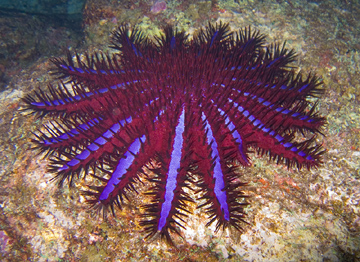Every decade or two, some of the biggest coral reefs in the Pacific and Indian oceans come under attack. Like monsters from a sci-fi movie, waves of giant creatures swarm over the reefs, leaving behind dead skeletons. And so far, scientists aren’t sure just what causes these attacks.
 Crown of thorns sea star. Credit: Jon Hanson
Crown of thorns sea star. Credit: Jon HansonThe invaders are a species of sea star known as “crown of thorns.” It’s one of the biggest of all the sea stars. An adult typically spans a foot, and sometimes two feet. It typically has more than a dozen arms, and its body is covered with venomous spines that give the critter its name.
Over the last 50 years, three waves of them have besieged Australia’s Great Barrier Reef. Other large reefs have also been attacked. The infestations last several years, until the sea stars are killed by disease or they eat up the available food.
Their favorite food is coral polyps -- the living organisms that give coral its color. The sea stars climb over the coral, extrude their stomachs, and dissolve the polyps. They spend up to half their time eating, so they can destroy reefs in a hurry.
The outbreaks could be caused by natural variations in the crown-of-thorns population. But they could also be caused by overfishing of the predators that normally keep the starfish under control. Or they could be caused by extra nutrients from human activities onshore, which sustain young crowns of thorns until they grow up to be coral killers. No matter the cause, though, the crown of thorns is an unwelcome visitor on any coral reef.

